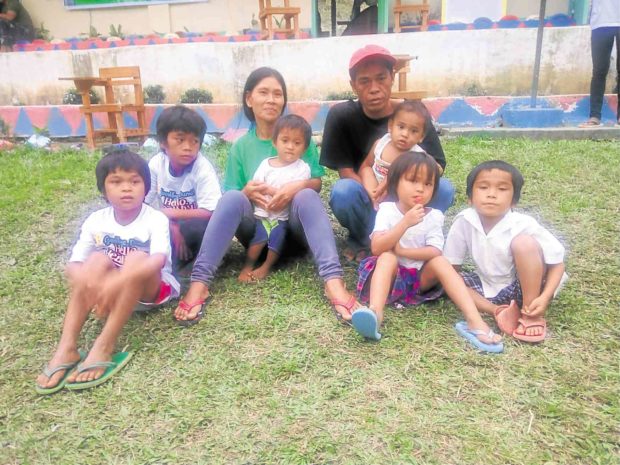Boy’s death gives life to nutrion programs in Zambo Sur village
LABANGAN, Zamboanga del Sur — The death of a 12-year-old boy of hunger had given life to efforts to save other children in an impoverished community here and elsewhere from the silent killer known as malnutrition.
The death of Jonathan Oya last Feb. 14 at home in the village of Cogonan drew attention to the severe lack of nutrition, not only of children in the Oya neighborhood but everywhere ignorance and poverty combine to form a deadly brew.
In the Oya neighborhood, a farming community of lumad called Glab, parents used to feed their children rice, dried fish or salted anchovy, whichever was available. They had learned to put vegetables in the mix.
Regular checkups
They now also make regular visits to the village health center no matter its distance from their homes.
Article continues after this advertisementBombina Oya, Jonathan’s aunt who has 11 children, said she learned lessons from the death of her nephew.
Article continues after this advertisement“We don’t want that what happened to Jonathan to be repeated,” Bombina said.
Sacrifice
Other parents in the predominantly Subanen village said Jonathan’s death was tragic but served as a wake-up call.
Norma Pangpang, 45, and resident of Cogonan, said she was worried for two of her seven children aged 7 and 10.
She said like Jonathan, her two children were frail and had to walk for hours from home to school and back.
But since Jonathan’s death, Norma said she started serving nutritious meals to her children.
She also started bringing her children to regular checkups at the village health center.
“It is quite far but we need to make some sacrifice for their health,” Norma said.
Winnie Oya, Jonathan’s father, admitted that malnutrition had stalked the family even before Jonathan suffered from it.
He said five months before Jonathan was diagnosed with and died of severe malnutrition, another son — 10-year-old Bennie — had died also because of severe lack of nutrition.
Winnie, now in his 50s, said Jonathan’s death opened the family’s and other villagers’ eyes to the need for proper nutrition.
“We now serve them vegetables,” he said.
Priority to education
Winnie said his family was now focusing on the health of seven of their young children. Other children are now adults with their own families.
“We are also prioritizing their education,” he said, adding that they might move to a house nearer the children’s school.
Winnie added that the family had become active in community meetings to get updates on health and other government programs being implemented in their village.
CheckMySchool, a nongovernment organization that partnered with the Department of Education to address issues confronting children in 893 schools across the country, had tapped other groups for a feeding program for children of Glab.
Faye Reyes, CheckmySchool coordinator in Labangan, had brought to public attention the condition of children in Glab through Jonathan’s case.

Jonathan Oya in a Pagadian City hospital shortly before he died of severe malnutrition. IRENE CABIASAN
Among the groups that responded after the Inquirer carried Jonathan’s story was the Negrense Volunteers for Change (NVC).
Mingo Meals
“Jonathan’s story got us searching for his home,” said NVC’s Millie Kilayko.
She said an NVC team started a program to feed 175 children with Mingo Meals, a mix of rice, mung beans and malunggay.
While Mingo was “primarily for infants” it was now being served to other children in Glab “to help them build strong bodies and sharp minds,” Kilayko said.
Irene Cabiasan, Jonathan’s school adviser, said teachers at Glab Elementary School now regularly visit their students’ homes to check on them and encourage their parents to coordinate with the school or health authorities if their children got ill.
Learn to cook
Parents are also now active in cultivating banana and cassava which were being served as children’s snacks.
Cabiasan said the school fed not only 26 severely malnourished children but “all 154 kids in the school including their siblings who were not yet enrolled.”
Teachers also offered cooking lessons so parents could serve “good-tasting nutritious food for their children,” she said.
Subanen chieftain Timuay Braulio Anlimon said the tribe was grateful for the government response to malnutrition in the lumad community but wished that it would also address poverty.
“Don’t give them fish, teach them how to fish,” Anlimon said.
Cerning Bicagas, village chief of Cogonan, said one way the government could address poverty was to build an access road to Glab and other interior areas of Cogonan to help farmers bring their produce to markets.
“The people are industrious but they spend a lot just to bring their products to the market,” Bicagas said. “The lack of access road brings their earnings down.”
He said for example, a farmer in Glab had to spend at least P3 per kilogram of palay that he was transporting, an amount barely affordable for a farmer in the community.
